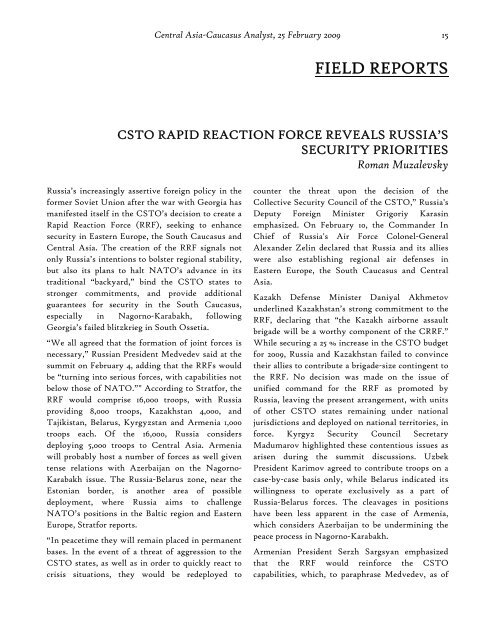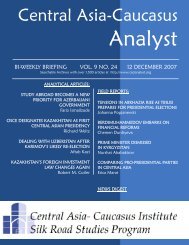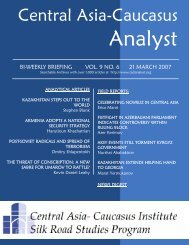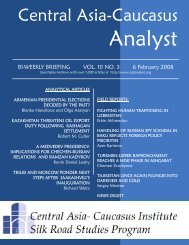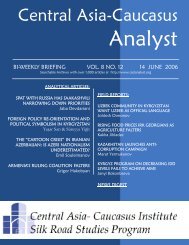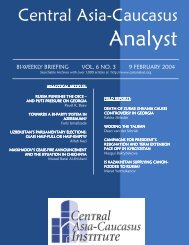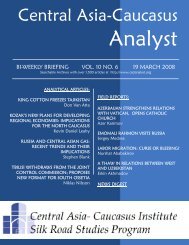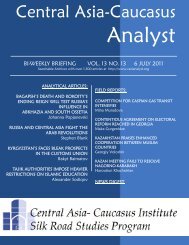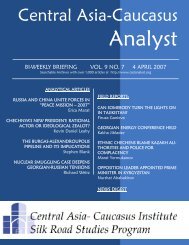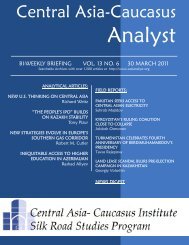Central Asia-Caucasus - The Central Asia-Caucasus Analyst
Central Asia-Caucasus - The Central Asia-Caucasus Analyst
Central Asia-Caucasus - The Central Asia-Caucasus Analyst
Create successful ePaper yourself
Turn your PDF publications into a flip-book with our unique Google optimized e-Paper software.
<strong>Central</strong> <strong>Asia</strong>-<strong>Caucasus</strong> <strong>Analyst</strong>, 25 February 2009 15<br />
FIELD REPORTS<br />
CSTO RAPID REACTION FORCE REVEALS RUSSIA’S<br />
SECURITY PRIORITIES<br />
Roman Muzalevsky<br />
Russia’s increasingly assertive foreign policy in the<br />
former Soviet Union after the war with Georgia has<br />
manifested itself in the CSTO’s decision to create a<br />
Rapid Reaction Force (RRF), seeking to enhance<br />
security in Eastern Europe, the South <strong>Caucasus</strong> and<br />
<strong>Central</strong> <strong>Asia</strong>. <strong>The</strong> creation of the RRF signals not<br />
only Russia’s intentions to bolster regional stability,<br />
but also its plans to halt NATO’s advance in its<br />
traditional “backyard,” bind the CSTO states to<br />
stronger commitments, and provide additional<br />
guarantees for security in the South <strong>Caucasus</strong>,<br />
especially in Nagorno-Karabakh, following<br />
Georgia’s failed blitzkrieg in South Ossetia.<br />
“We all agreed that the formation of joint forces is<br />
necessary,” Russian President Medvedev said at the<br />
summit on February 4, adding that the RRFs would<br />
be “turning into serious forces, with capabilities not<br />
below those of NATO.”" According to Stratfor, the<br />
RRF would comprise 16,000 troops, with Russia<br />
providing 8,000 troops, Kazakhstan 4,000, and<br />
Tajikistan, Belarus, Kyrgyzstan and Armenia 1,000<br />
troops each. Of the 16,000, Russia considers<br />
deploying 5,000 troops to <strong>Central</strong> <strong>Asia</strong>. Armenia<br />
will probably host a number of forces as well given<br />
tense relations with Azerbaijan on the Nagorno-<br />
Karabakh issue. <strong>The</strong> Russia-Belarus zone, near the<br />
Estonian border, is another area of possible<br />
deployment, where Russia aims to challenge<br />
NATO’s positions in the Baltic region and Eastern<br />
Europe, Stratfor reports.<br />
“In peacetime they will remain placed in permanent<br />
bases. In the event of a threat of aggression to the<br />
CSTO states, as well as in order to quickly react to<br />
crisis situations, they would be redeployed to<br />
counter the threat upon the decision of the<br />
Collective Security Council of the CSTO,” Russia's<br />
Deputy Foreign Minister Grigoriy Karasin<br />
emphasized. On February 10, the Commander In<br />
Chief of Russia's Air Force Colonel-General<br />
Alexander Zelin declared that Russia and its allies<br />
were also establishing regional air defenses in<br />
Eastern Europe, the South <strong>Caucasus</strong> and <strong>Central</strong><br />
<strong>Asia</strong>.<br />
Kazakh Defense Minister Daniyal Akhmetov<br />
underlined Kazakhstan’s strong commitment to the<br />
RRF, declaring that “the Kazakh airborne assault<br />
brigade will be a worthy component of the CRRF.”<br />
While securing a 25 % increase in the CSTO budget<br />
for 2009, Russia and Kazakhstan failed to convince<br />
their allies to contribute a brigade-size contingent to<br />
the RRF. No decision was made on the issue of<br />
unified command for the RRF as promoted by<br />
Russia, leaving the present arrangement, with units<br />
of other CSTO states remaining under national<br />
jurisdictions and deployed on national territories, in<br />
force. Kyrgyz Security Council Secretary<br />
Madumarov highlighted these contentious issues as<br />
arisen during the summit discussions. Uzbek<br />
President Karimov agreed to contribute troops on a<br />
case-by-case basis only, while Belarus indicated its<br />
willingness to operate exclusively as a part of<br />
Russia-Belarus forces. <strong>The</strong> cleavages in positions<br />
have been less apparent in the case of Armenia,<br />
which considers Azerbaijan to be undermining the<br />
peace process in Nagorno-Karabakh.<br />
Armenian President Serzh Sargsyan emphasized<br />
that the RRF would reinforce the CSTO<br />
capabilities, which, to paraphrase Medvedev, as of


